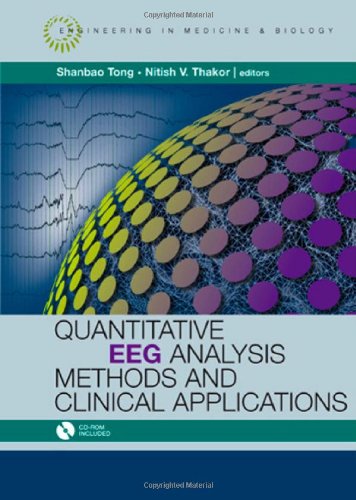(Ebook) Quantitative EEG analysis methods and clinical applications by Shanbao Tong, Nitish V. Thankor ISBN 9781596932043, 9781596932050, 159693204X, 1596932058
Are you a biomedical scientist working on neural signal processing and interpretation or a biomedical- or neural engineer who is working on qEEG analysis methods and developing novel clinical instrumentation? If you are, then this book is for you! Editors Shanbao Tong and Nitish V. Thankor, have done an outstanding job of editing a book which includes contributed chapters by leading scientists in their respective qEEG area, that provides an introduction to basic and advanced techniques used in qEEG analysis, and present some of the most successful qEEG applications. Author Paul Nunez, begins with an examination of the physiological foundations of the generation of EEG signals. Next, authors Ingmar Gutberlet, Stefan Debener, Tzyy-Ping and Scott Makeig, explain how to effectively record the microvolt level of EEG signals and remove any artifacts. Then, authors Hasan Al-Nashash, Shivkumar Sabesan, Balu Krishnan, Jobi George, Konstantinos Tsakalis, Leon Iasermidis, and Shanbao Tong, review the most commonly used quantitative EEG analysis methods for single-channel EEG signals, including linear methods, nonlinear descriptors, and statistical measures. Author Rodrigo Quian Quiroga continues by introducing the four most important techniques for analyzing the interdependence between different EEG channels: cross-correlation, coherence, mutual information, and synchronization. Next, author Roberto Pascual-Marqui, describes the EEG source localization, also known as the EEG inverse problem. Then, authors Nicholas Fisher, Sachin Talathi, Alex Cadotte and Paul Carney, present one of the most successful clinical applications of qEEG--the detection and monitoring of epileptic seizures. Authors Nitish Thakor, Xiaofeng Jia and Romergryko Geocadin, continue by describing how EEG signals change following hypoic-ischemic brain injury. Next, authors Bo Hong, Yijun Wang, Xiaorong Gao and Shangkai Gao, interpret how qEEG techniques could be used as a direct nonmuscular communication channel between the brain and the external world. Then, author Ira Rampil provides an overview of the clinical utility of assessing the anesthetic response in individual patients undergoing routine surgery. Authors Paul Carney, Nicholas Fisher, William Ditto and James Geyer, continue by presenting an overview of the application of qEEG in one of the most fundamental aspects of everyone's life: sleep. Next, authors Ian Cook, Aimee Hunter, Alexander Korb, Haleh Farabod and Andrew Leuchter, review the history of qEEG analysis in psychiatry and present the application of qEEG as a biomarker for psychiatric disorders. Then, authors Michael Wagner, Soumyadipta Acharya, Joseph Paul, and Nitish Thakor, introduce technologies registering the fMRI and EEG source images based on the volume conduction model. Authors Laura Astolfi, Andrea Tocci, Fabrizo De Vico Fallani, Febo Cincotti, Donatella Mattia, Serenella Salinari, Maria Grazia Marciani, Alfredio Colosimo and Fabio Babiloni, continue by presenting a methodology to assess cortical activity by estimating statistically significant sources using noninvasive high-resolution electroencephalography. Finally, authors Nathan Crone, Anna Korzeniewska, Supratim Ray and Piotr Franaszczuk, review how the advantages of intracranial EEG (iEEG) have been exploited in recent years to map the human cortical function for both clinical and research purposes. This most excellent reference handbook, should be used primarily by biomedical scientists, clinicians and engineers in the R&D departments of biomedical companies. More importantly, this handbook should also be used by graduate students in neural engineering.
*Free conversion of into popular formats such as PDF, DOCX, DOC, AZW, EPUB, and MOBI after payment.


